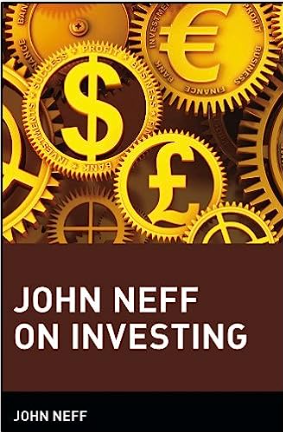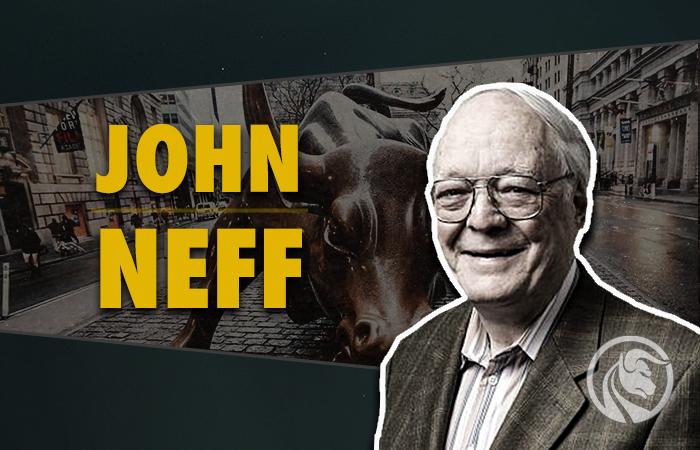John Neff - a master of consistency in beating the market
There are more and more online “one year heroes”, i.e. people who achieve spectacular rates of return. However, after a few years, their star fades significantly, and the market forgets about their existence. However, there are investors who, thanks to their proper approach to investment, are able to beat the market in the long run. An example of such a person is John Neff, who significantly beat the S&P 500 index in three decades. John Neff reached then average annual rate of return level of 13,7%. In the same period, the benchmark, i.e S&P 500 index generated a CAGR of 10,6%. This is what the fund managed by Neff has achieved. The fund's performance was so good that it was closed to investors in the 80s. The reason was that it had reached such a large size that additional capital would lead to a reduction in the rate of return on investment. In today's article, we will briefly describe the history and investment strategy of this investor.
Who was John Neff?
John Neff was born on September 19, 1931 in Wauseon, Ohio. Thus, early childhood coincided with the times of the American economy coming out of Great Depression. He came from a broken family. John's parents divorced shortly after his birth. A great help for the family during the Great Depression was the grandfather, who tried to improve the household budget.
John himself started working at a young age. He was helped by his father, who offered him a job in a company that produced car parts and lubricants. Despite the difficult financial situation, young John Neff did not neglect his education. In 1955, he graduated with honors from the University of Toledo.

University of Toledo. Source: wikipedia.org
Not graduating from the most reputable schools in the US initially hindered career development. However, thanks to diligence, intelligence and seizing the opportunity, John Neff finally began his career in the capital market.
After graduating, in January 1955, the investor hitchhiked to New York to find work as a stockbroker. He failed to realize his dreams. He joined the National City Bank of Cleveland as a securities analyst. Working eight years in National City, he gained capital and valuable experience.
He also earned an MBA in accounting and finance from Case Western Reserve University, graduating in 1958. Then he started studying at the Business School, which was organized at Western Reserve University. He graduated from it in 1958.
In the early 60's he was offered a position at Wellington Management Company, where he stayed "sub-advisor" groups of funds Vanguard. He was promoted after 3 years in the company to a portfolio manager of Windsor, Gemini and Qualified Dividend funds. Thanks to his vast knowledge and persuasiveness, he managed to set up his own fund (Vanguard Windsor Fund). John managed it from 1964 to 1995. The fund generated a very good rate of return, which was approximately 13,7% per annum. This made John one of the stars Wall Street. It also encouraged him to write a book in which he shares his thoughts on investing in the stock market.
Investment strategy
Beating the market for 30 years is no accident. So what was Neff's advantage? One of the most important of them was buying cheap companies that were unpopular with investors for some reason. He looked for companies that appeared at 52-week lows. Of course, the downtrend alone wasn't enough to make John's list of potential purchases. After all, there are many companies that are classic value trap.
The value trap is a situation when the market evaluates a company at a significant discount to other companies of this type. However, behind this discount there is usually a shrinking business or other problems. Years later, it turns out that the share price is still heading south. The reason is the deteriorating foundations.
John Neff tried to buy companies that were overpriced because of market sentiment, not the company's real prospects. For John, it was important that companies valued with a low P/E ratio were able to generate revenue and profit growth of at least 7%.
John Neff tried to avoid companies that grew very fast. This was due to the fact that such companies were most often liked by investors. For this reason, the positive business growth scenario was already discounted in the valuation. In a situation where the company fails to deliver the assumed growth rate, the exchange rate will be corrected.
Cash flow was also important to Neff. The higher the FCF, the easier it will be for the company to pay dividends and make significant investments in the future. At the same time, the company should generate sufficient cash to finance dividend payments and further growth.
For this reason, John looked for companies with growing profits, generating large amounts of cash and sharing excess capital with shareholders. The acquired cash could be invested in the most promising companies. He very often bought companies that had a dividend yield (dividend to capitalization ratio) of 4%-5%.
John Neff was also not very committed to sectoral diversification. There were situations when the fund managed by him concentrated its activity in particular segments. For example, at the end of the 80s, almost 40% of the portfolio consisted of companies related to the financial sector.
Another feature that distinguished Neff was consistency. He was attached to his strategy. As a result, he stuck to his strategy also in periods when it generated worse results than the competition. Once he had selected companies for his portfolio, he did not constantly follow the market. He believed that many companies needed time for investors to discover that stocks were undervalued. John Neff himself believed that time is always an ally of good companies and an enemy of poorly managed companies.
Although he was a fundamental investor, he did not want to hold the stock until his death. He preferred to get rid of them when they reached their target levels. Sometimes this resulted in him selling a company that was only halfway up. However, it was in line with the assumptions of this investor. Instead of maximizing profits from one transaction, John focused on repetition. Neff developed his own strategy that allowed him to assess how much was left "common sense" space for growth. If there was little room for growth left, he sold shares without regret. It is worth noting that he approached the valuation of companies flexibly. If there was information that changed the fundamentals of the company, he updated his valuation.
The remaining activities of John Neff
John Neff did not just work for the fund. In 1980, he became chairman of the Investment Council at the University of Pennsylvania. At the time, the results of the university fund were among the worst in the country. After 18 years of managing the university's funds, they increased from $200 million to $3 billion. His work was pro bono. The only benefit was the possibility of parking on the premises of the university.
He was also involved in numerous projects. He was a member of the CFA Federation. The said organization is related to the famous certificate called Chartered Financial Analysts (CFA). He was also a lecturer at Wharton and a member of the Advisory Board at the Weiss Center for International Financial Research in Warthon. For his contribution to educational activities, he received the title of Doctor Honoris Causa from the University of Toledo and the University of Pennsylvania. He was also named one of the 10 greatest investors of the XNUMXth century by Fortune.

John Neff on Investing. Source: Amazon.com
John Neff in 1999 published an autobiography entitled “John Neff on Investing”. The book was his diary where he revealed his history as well as the investment techniques he used.
The book written by Jeff has received many positive reviews. Robert Barker and Hardy Green in Business Week named her “a thoughtful combination of investing theory and autobiography”. In turn, Rich Blake in Institutional Investor wrote that “The value investor is not afraid to invest against the crowd, even if the crowd is large, noisy […]”. In the next excerpt from the review, Rich mentioned that “Both the professional and the novice investor will benefit from the author's insights”.
Advice from John Neff to other investors
John Neff shared his thoughts on investing through interviews and his book. It is worth looking at what an investor who has been able to beat the market for 30 years has to say. Here are some pieces of advice he gave to budding investors:
- First of all, discipline “John believed that lack of discipline was a huge threat to long-term profits. Without consequences, the investor will not be able to cope with periods of poor returns (e.g. bear market). Lack of consistency will cause the investor to constantly change investment strategies.
- Don't be afraid of taking risks – According to Neff, in order to make a profit, you have to expose yourself to risk. There is no way to make an above-average profit without risking. However, you should always do it with your head. John believed that you shouldn't risk it for the adrenaline. You should always estimate the risk to potential reward ratio.
- Approach investing professionally – you should not buy stocks just because they are popular. Instead, look for values. Very often, the greatest chance for above-average profits are in companies that are: forgotten, disliked, misunderstood. So investing in value is not easy.
- Don't just think about the company. Also check the industry – even the best company will not have it easy in a difficult industry. For this reason, you should always check the microeconomic and macroeconomic environment in which the company operates. Even the best-managed company will not generate profits if it operates in a terrible industry.
Summary: Invest against the current but with a plan
Neff tried invest in companies valued at a discount to their intrinsic value. Very often, the shares purchased had a low value price to net profit ratio and the prospect of share price growth in the future.
He very often approached investing in a contrarian way. He liked to buy companies that the market didn't like for some reason. However, the strategy wasn't just about buying companies that are at annual lows. The company had to meet standards regarding the company's prospects, the quality of management and the company's possible competitive advantages. Neff really liked when the acquired company had high return on equity (ROE). Of course, at the same time, he avoided companies that achieved high ROE only because of high financial leverage.
John Neff was there too patient. He didn't care about momentary market fluctuations. Instead, he spent time looking for overpriced companies and understanding the business model of each of the companies he analyzed.
He himself thought so the investor should hold 70% - 80% of assets in shares. Of course, he advised investing in good quality companies that are valued very cheaply. He believed that every investor, when making an investment decision, should know exactly why he is buying a given asset.
Summation
John Neff is another example of a value investing manager who has beaten the market. He gained an advantage over the market by acquiring good companies at a great price. His approach to investing was often contrarian. He bought stocks of companies that were down and waited for the market to see that the company's problems were temporary. When the script materialized, he sold stocks and looked for other opportunities.






















![Forex Club – Tax 9 – Settle tax on a foreign broker [Download the Application] Forex Club - Tax 9](https://forexclub.pl/wp-content/uploads/2024/02/Forex-Club-Podatek-9-184x120.jpg?v=1709046278)
![Trading View platform – solutions tailored to the needs of traders [Review] trading view review](https://forexclub.pl/wp-content/uploads/2024/03/trading-view-recenzja-184x120.jpg?v=1709558918)
![How to connect your FP Markets account to the Trading View platform [Guide] fp markets trading view](https://forexclub.pl/wp-content/uploads/2024/02/fp-markets-trading-view-184x120.jpg?v=1708677291)
![How to invest in ChatGPT and AI? Stocks and ETFs [Guide] how to invest in chatgpt and artificial intelligence](https://forexclub.pl/wp-content/uploads/2023/02/jak-inwestowac-w-chatgpt-i-sztuczna-inteligencje-184x120.jpg?v=1676364263)


![WeWork – the anatomy of the collapse of a company valued at $47 billion [WeWork, part II] wework bankruptcy story](https://forexclub.pl/wp-content/uploads/2024/04/wework-bankructwo-historia-184x120.jpg?v=1711729561)
![Adam Neumann – the man who screwed up Softbank [WeWork, part AND] adam neumann wework](https://forexclub.pl/wp-content/uploads/2024/04/adam-neumann-wework-184x120.jpg?v=1711728724)





![How to transfer shares to another brokerage office [Procedure description] how to transfer shares to another brokerage house](https://forexclub.pl/wp-content/uploads/2024/03/jak-przeniesc-akcje-do-innego-biura-maklerskiego-184x120.jpg?v=1709556924)

![The most common mistakes of a beginner trader - Mr Yogi [VIDEO] Scalping - The most common mistakes of a beginner trader - VIDEO](https://forexclub.pl/wp-content/uploads/2024/03/Scalping-Najczestsze-bledy-poczatkujacego-tradera-VIDEO-184x120.jpg?v=1711601376)
![Learning patience: No position is also a position - Mr Yogi [VIDEO] Scalping - Learning patience - No position is also a position - VIDEO](https://forexclub.pl/wp-content/uploads/2024/03/Scalping-Nauka-cierpliwosci-Brak-pozycji-to-tez-pozycja-VIDEO-184x120.jpg?v=1710999249)
![When to exit a position and how to minimize losses - Mr Yogi [VIDEO] Scalping - When to exit a position and how to minimize losses - VIDEO](https://forexclub.pl/wp-content/uploads/2024/03/Scalping-Kiedy-wyjsc-z-pozycji-i-jak-minimalizowac-straty-VIDEO-184x120.jpg?v=1710336731)



![How to invest in ChatGPT and AI? Stocks and ETFs [Guide] how to invest in chatgpt and artificial intelligence](https://forexclub.pl/wp-content/uploads/2023/02/jak-inwestowac-w-chatgpt-i-sztuczna-inteligencje-300x200.jpg?v=1676364263)












